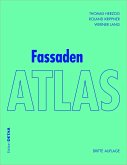Façades determine the appearance of a building. Hence, they constitute a major element in architecture. At the same time, the building’s envelope has important functions to fulfil, such as lighting, weatherproofing, thermal insulation, load transfer and sound insulation. Over the past 15 years, façades have become increasingly complex – ‘intelligent’ facades, for instance, adapt to changing climate and lighting conditions. Newly developed materials and technologies have broadened the scope of façade functions. This book demonstrates the principles of façade construction. It systematically describes the most common types, such as post-and-beam façade, curtain wall, corridor façade or double façade, and provides guidelines for appropriate detailing. Numerous drawings made especially for the book explain the principles of different types of facades, which are then illustrated with built examples. For this second edition, all chapters were revised and all four examples in the case studies chapter were replaced by new material. The new chapter "Future Facades” offers insights into what’s next.
Fassaden bestimmen die Erscheinung eines Gebäudes, sie verkörpern es gleichsam. Somit kommt ihnen in der Architektur große Bedeutung zu. Gleichzeitig nimmt die Gebäudehülle zentrale Aufgaben wahr - Belichtung, Wetterdichtigkeit, thermische Isolation, Lastenabtragung, Schallschutz, um nur die wichtigsten Funktionen zu nennen. Über die letzten 15 Jahre sind Fassaden erheblich komplexer geworden und die Entwicklung hält an: intelligente, klima-aktive Fassaden beispielsweise passen sich durch selbstregelnde Systeme den verschiedenen Licht- und Klimaverhältnissen an, neu entwickelte Materialien und Technologien haben die Funktionalität der Fassade stark erweitert. Dieses Buch zeigt die Prinzipien der Fassade. Zunächst werden die wichtigsten Typen wie Pfosten-Riegel-Fassade, Vorhangfassade, Elementfassade, Doppelfassade vorgestellt, dann werden ihre Anforderungen an Entwurf und Konstruktion verdeutlicht. Zahlreiche, eigens für dieses Buch entstandene Zeichnungen erklären die einzelnen Fassadentypen und zeigen diese dann am gebauten Beispiel. Für die Neuausgabe wurden die Kapitel aktualisiert, sämtliche Beispiele komplett neu erstellt und das neue Kapitel "Zukünftige Fassaden" gibt einen Ausblick.
Fassaden bestimmen die Erscheinung eines Gebäudes, sie verkörpern es gleichsam. Somit kommt ihnen in der Architektur große Bedeutung zu. Gleichzeitig nimmt die Gebäudehülle zentrale Aufgaben wahr - Belichtung, Wetterdichtigkeit, thermische Isolation, Lastenabtragung, Schallschutz, um nur die wichtigsten Funktionen zu nennen. Über die letzten 15 Jahre sind Fassaden erheblich komplexer geworden und die Entwicklung hält an: intelligente, klima-aktive Fassaden beispielsweise passen sich durch selbstregelnde Systeme den verschiedenen Licht- und Klimaverhältnissen an, neu entwickelte Materialien und Technologien haben die Funktionalität der Fassade stark erweitert. Dieses Buch zeigt die Prinzipien der Fassade. Zunächst werden die wichtigsten Typen wie Pfosten-Riegel-Fassade, Vorhangfassade, Elementfassade, Doppelfassade vorgestellt, dann werden ihre Anforderungen an Entwurf und Konstruktion verdeutlicht. Zahlreiche, eigens für dieses Buch entstandene Zeichnungen erklären die einzelnen Fassadentypen und zeigen diese dann am gebauten Beispiel. Für die Neuausgabe wurden die Kapitel aktualisiert, sämtliche Beispiele komplett neu erstellt und das neue Kapitel "Zukünftige Fassaden" gibt einen Ausblick.








